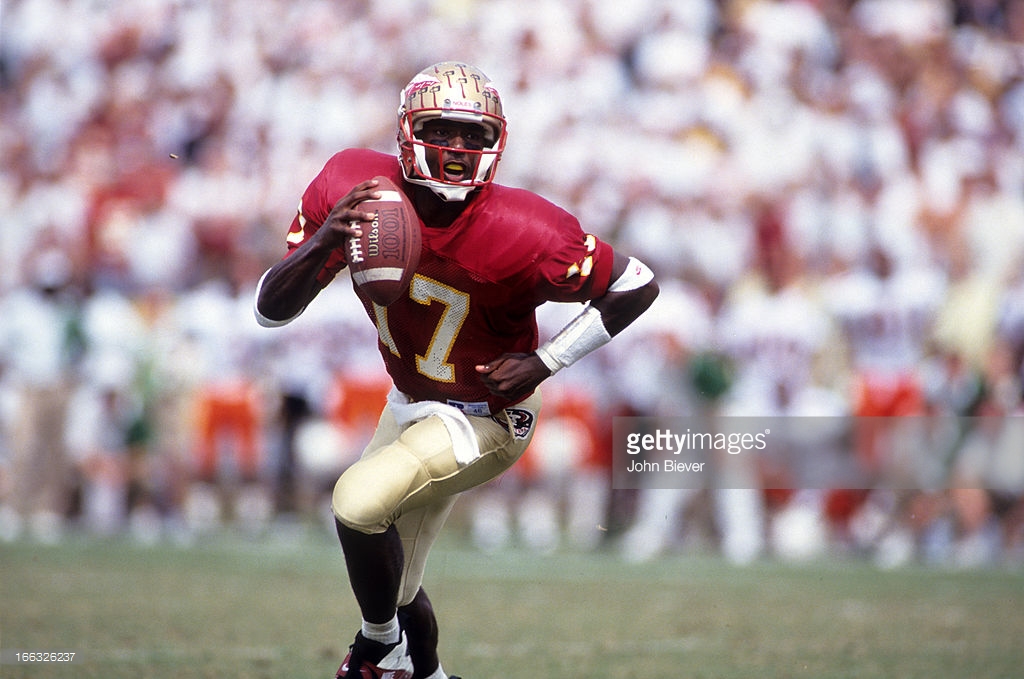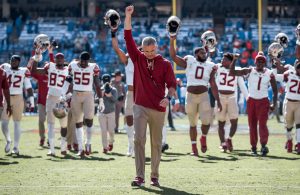There are 20 days left until Florida State football starts the 2018 season. As part of the offseason, we’re highlighting players, games, and specific moments from FSU football history.
On Monday, it was legendary cornerback Terrell Buckley and his school-record 21 career interceptions.
Today, it’s Florida State’s 20 seasons of finishing in the AP top 10.
Top-10 finishes have become routine for Florida State, but for a program that got started in 1947, the rise to the top was a slow one. The Seminoles were in their 18th year in existence before finishing ranked when they placed No. 11 in the final UPI Poll in 1964. It would be 15 years later before FSU finally finished in the top 10.
The year was 1979 as the Seminoles finished their fourth regular season under head coach Bobby Bowden undefeated. FSU ascended to No. 4 in the country before finishing sixth with an 11-1 record after a 24-7 Orange Bowl loss to Oklahoma.
The following season would see Florida State finish in the top 5 for the first time. The Seminoles finished 10-2 in 1980 with both losses coming at the Orange Bowl and by a single point. After falling to Miami 10-9 during the regular season, FSU was defeated by Oklahoma in the Orange Bowl for a second straight season, 18-17.
It would be seven years later before Florida State would again finish in the top 10 or the top 5 for that matter. But from 1987 forward, it would be a long time before FSU finished outside of the top 5.
The 1987 season culminated in a 31-28 win over Nebraska in the Fiesta Bowl and a No. 2 national ranking. It would begin a run unlikely to be paralleled in college football history.
From 1987 until 2000, FSU finished in the top 5 every year. The Seminoles claimed national championships in 1993 and 1999 and played for three more in 1996, 1998 and 2000.

Bobby Bowden’s first of two national championships was capped with an 18-16 win over Nebraska in thw 1994 Orange Bowl. (Rick Stewart/Getty Images)
After accomplishing that feat in 14 straight years, the highest that Florida State would finish over Bowden’s final nine seasons would be No. 11 in 2003. In 2010, offensive coordinator Jimbo Fisher was promoted to head coach following Bowden’s retirement and wasted little time reviving the program.
After going 19-8 in the first two seasons under Fisher, Florida State began its return to prominence in 2012. Following a 10-2 regular season, FSU captured its first ACC title in seven years with a win over Georgia Tech in Charlotte for the conference crown before throttling Northern Illinois in the Orange Bowl, 31-10.

Lonnie Pryor rushed for 134 yards and two touchdowns in the 2013 Orange Bowl. (Steve Musco/FSU athletics)
With a redshirt freshman quarterback and eventual Heisman Trophy winner named Jameis Winston, the Seminoles would score more points in 2013 than any FBS team ever en route to a 14-0 season and a third national championship. FSU would go undefeated during the regular season the following year and win a third straight ACC title before falling to Oregon in the Rose Bowl in what would be college football’s first-ever national semifinal. FSU finished the season ranked No. 5 in the AP Poll.
The most recent top-10 finish for Florida State came in 2016. The Seminoles overcame a disappointing 3-2 start to win seven of their final eight games capped with a thrilling 33-32 win over Michigan in the Orange Bowl. FSU finished with a final AP ranking of eighth.
Since 1979, Florida State has finished in the top 10 in 20 of 39 seasons under two head coaches. A new day will soon be dawning under head coach Willie Taggart, who will try to continue a winning tradition and lead FSU to a top-10 ranking with regularity. If we’ve learned anything about Taggart in a short time, it’s that he’s a fan of tradition.
Mike Ferguson is the editor of The Daily Nole. Follow Mike on Twitter @MikeWFerguson
 John Biever /Sports Illustrated/Getty Images
John Biever /Sports Illustrated/Getty Images





You must be logged in to post a comment Login